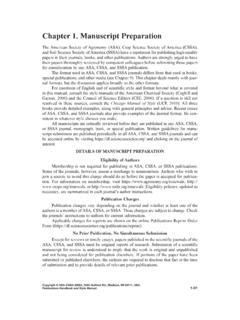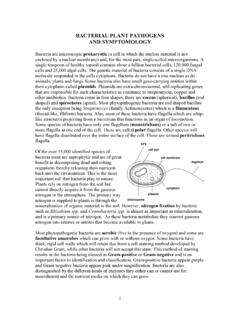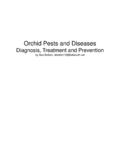Transcription of Alfalfa Management Guide - Agronomy
1 Alfalfa Management GuideAuthorsDan UndersanderExtension agronomist, forages University of WisconsinDennis CosgroveExtension agronomist, forages University of WisconsinEileen CullenExtension entomologist University of WisconsinCraig GrauExtension plant pathologist University of WisconsinMarlin E. RiceExtension entomologist Iowa State UniversityMark RenzExtension agronomist, weed control University of WisconsinCraig SheafferResearch agronomist University of MinnesotaGlen ShewmakerExtension agronomist University of IdahoMark SulcExtension agronomist The Ohio State UniversityAlfalfa Management Guide iiAlfalfa Management Guide AcknowledgmentsThe authors wish to thank reviewers from industry and various universities for their suggestions and everyone who supplied photos, including those not specifically mentioned:Steve Bicen, University of Wisconsin anthracnose; aphanomyces, roots; Fusarium wilt , roots; Phytophthora, roots; root assessment; verticillium wilt , rootDennis Cosgrove, University of Wisconsin autotoxicityJim Ducy title page photoDel Gates, Kansas State University Alfalfa weevils Craig Grau, University of Wisconsin apha-nomyces, stunting; bacterial wilt , stunting; black stem, lesions; Fusarium wilt , field; Phytophthora, plant.
2 Sclerotinia; stand assessment; verticillium wilt , plantsB. Wolfgang Hoffmann, University of Wisconsin Alfalfa plant, page 1; Alfalfa flowersEric Holub, University of Wisconsin aphano-myces, seedling Jeffrey S. Jacobsen, Montana State University nutrient deficiencies all except boron leaf (from Diagnosis of Nutrient Deficiencies in Alfalfa and Wheat) Pioneer Hi-Bred International, Inc. Alfalfa closeups; cover photo ; cow; inside cover Lanie Rhodes, Ohio State University black stem, leaves; common leaf spot; lepto leaf spot Marlin E. Rice, Iowa State University Alfalfa weevil, blister beetles; clover leaf weevils; grasshopper; pea aphids; plant bug, adults; potato leafhopper, adult; spittlebug; variegated cutwormJudy A. Thies, USDA-ARS root-lesion nematodes John Wedberg, University of Wisconsin Alfalfa blotch leafminer; clover root curculio, damage Thanks also to Bruce Gossen and R eal Michaud, research scientists at Agriculture and Agri-Food Canada, for their contribu-tions to the disease publication is a joint effort of:University of Wisconsin-Extension, Cooperative ExtensionMinnesota Extension Service, University of MinnesotaIowa State University Cooperative Extension ServicePublished by:American Society of Agronomy , Inc.
3 Crop Science Society of America, Inc. Soil Science Society of America, Inc. 2011 by American Society of Agronomy , Inc., Crop Science Society of America, Inc., and Soil Science Society of America, RIGHTS RESERVED. No part of this publication may be reproduced or transmit-ted in any form or by any means, electronic or mechanical, including photocopying, recording, or any information storage and retrieval system, without permission in writing from the publisher. Any and all uses beyond the limitations of the fair use provision of the law require written permission from the publishers; not applicable to contributions prepared by offi-cers or employees of the Government as part of their official views expressed in this publication represent those of the individual Editors and Authors. These views do not necessar-ily reflect endorsement by the Publisher(s). In addition, trade names are sometimes mentioned in this publication. No endorse-ment of these products by the Publisher(s) is intended, nor is any criticism implied of similar products not : 978-0-89118-179-8 Library of Congress Control Number: 2010918141 Editor: Lisa Al-Amoodi Designer: Patricia ScullionEditor previous edition: Linda Deith Designer previous edition: Susan AndersonPrinted in the Society of Agronomy Crop Science Society of AmericaSoil Science Society of America5585 Guilford RoadMadison, WI 53711-5801 USATEL: 608-273-8080 FAX: a field type, drainage, and slope.
4 3 Control perennial weeds ..3 Autotoxicity ..3 Test soil before lime before seeding ..6 Nutrient needs during establishment ..7 Select a good potential ..8 Persistence ..8 Winterhardiness ..9 Fall dormancy ..9 Disease resistance ..9 Forage quality ..9 Intended use .. of seeding ..10 Field preparation ..11 Seed inoculation ..12 Seeding depth and rate ..12 Seeding with and without a companion crop ..13 Seeding equipment ..14 Reduced tillage and no-till planting .. needs ..18 Nitrogen ..20 Phosphate and potash ..20 Secondary nutrients ..21 Micronutrients .. Management before planting ..23 Weed Management in the seeding year ..23 Weed Management in established Alfalfa ..26 Disease ..29 Aphanomyces root rot ..30 bacterial wilt ..31 Common leaf spot and lepto leaf spot ..32 Fusarium wilt ..33 Phytophthora root rot ..34 Root-lesion nematodes ..35 Sclerotinia ..36 Spring black stem ..37 Summer black stem ..37 Verticillium wilt ..38 Insect blotch leafminer.
5 39 Alfalfa weevil ..39 Aphids ..41 Blister beetles ..41 Clover leaf weevil ..42 Clover root curculio ..43 Grasshoppers ..44 Plant leafhoppers ..45 Spittlebugs ..46 Variegated cutworm ..46 When to rotate from quality forage is needed? ..50 Plant growth and forage quality ..51 Harvest schedule ..52 Fall and silage considerations of hay and haylage ..56 ContentsProfitable forage production depends on high yields. Land, machinery, and most other operating costs stay the same whether harvesting 3 tons per acre or 6 tons per acre. Top yields in the northern United States have approached 10 tons per acre while average yields are around 3 tons per acre. This booklet describes what it takes to move from a 3-ton yield to 6 or 9 tons per acre. A vigorously growing, dense stand of Alfalfa forms the basis for prof-itable forage production. Profitable stands are the result of carefully selecting fields with well-drained soil, adding lime and nutrients if needed, selecting a good variety, and using appropriate planting practices to ensure germination and a field carefullySoil type, drainage, and slopeAlfalfa requires a well-drained soil for optimum production.
6 Wet soils create conditions suitable for diseases that may kill seedlings, reduce forage yield, and kill established plants. You can reduce some disease problems associ-ated with poor drainage by selecting varieties with high levels of resistance and by using fungicides for establish-ment. Poor soil drainage also reduces the movement of soil oxygen to roots. Poor surface drainage can cause soil crusting and ponding which may cause poor soil aeration, micronutri-ent toxicity, or ice damage over winter. Even sloping fields may have low spots where water stands, making it difficult to maintain Alfalfa should be deep enough to have adequate water-holding capacity. Alfalfa has a long taproot that pene-trates more deeply into the soil than crops such as corn or wheat which have more fibrous, shallow roots. Under favorable conditions, Alfalfa roots may penetrate over 20 feet deep. This great rooting depth gives Alfalfa excellent drought fields where erosion is a problem may require use of erosion control practices such as planting with a companion crop or using reduced tillage to keep soil and seed in place until seedlings are well rooted.
7 Control perennial weedsFields should be free of perennial weeds such as quackgrass. If not controlled before seeding, these weeds may re-establish faster than the new Alfalfa seedlings and reduce stand density. Weed Management is discussed in more detail in the Produc-tion should be free from herbicide carryover that may affect growth of the new Alfalfa and/or companion crop. This is especially important after drought years and on fields where high herbicide application rates or late-season applications of long-lasting herbicides were plants produce toxins that can reduce germination and growth of new Alfalfa seedings. This phenomenon is known as autotoxicity. The extent of the toxin s influence increases with the age and density of the previous stand and the amount of residue incorporated prior to autotoxic compounds are water soluble and are concentrated mainly in the leaves. The compounds impair development of the seedling taproot by causing the root tips to swell and by reducing the number of root hairs (Figure 1).
8 This limits the ability of the seedling to take up water and nutrients and increases the plant s susceptibility to other stress factors. Figure 1. Effect of autotoxicity on root development of : Jennings, Nelson, and Coutts, Universities of Arkansas and Missouri, 1998 autotoxins present normal plantsTo ensure good stands, calibrate seeding depths and rates carefully and plant in a firm, moist soil. 4 Alfalfa Management Guide Surviving plants will be stunted and continue to yield less in subsequent years (Figure 2). A waiting period after destroying the old stand is necessary to allow the toxic compounds to degrade or move out of the root zone of the new seedlings. Weather conditions influ-ence the speed with which the toxins are removed. Breakdown is more rapid under warm, moist soil conditions. The autotoxic compounds are removed more rapidly from sandy than more heavy textured soils. However, while the compounds are present, the effect on root growth is much more severe in sandy , grow a different crop for one season after plowing down or chemi-cally killing a 2-year or older stand before seeding Alfalfa again in the same field.
9 This is the best and safest way to manage new seedings of soil before plantingProper fertility Management , includ-ing an adequate liming program, is the key to optimum economic yields. Proper fertilization of Alfalfa allows for good stand establish-ment and promotes early growth, increases yield and quality, and improves winterhardiness and stand persistence. Adequate fertility also improves Alfalfa s ability to compete with weeds and strengthens disease and insect 2. Effect of waiting periods when establishing Alfalfa following Alfalfa . Note that even though the number of plants is similar for all but fields planted with no waiting, yield increases : Cosgrove et al., University of Wisconsin-River Falls, of autotoxicity on Alfalfa stands when Alfalfa is seeded (a) immediately following Alfalfa plowdown, (b) 4 weeks later, and (c) after 1 year. bca0 weeks2 weeks4 weeksfall-killedafter cornnumber of plants/ft2010203040500 weeks2 weeks4 weeksfall-killedafter cornyield (% of check variety)020406080100plowedno-till5 EstablishmentFields differ in their fertilizer needs.
10 Soil testing is the most convenient and economical method of evaluating the fertility levels of a soil and accurately assessing nutrient soil testing programs make recommendations for pH and lime, phosphorus, potassium, and several of the secondary nutrients and micronutri-ents. Optimal soil test levels for Alfalfa differ among states due to varying subsoil fertility, nutrient buffering capacities, soil yield potentials, and different Management assumptions. For more detailed information on soil test recommendations, contact your local Extension TechniquesReseeding recommendationsReseeding stands within 1 year carries a certain amount of risk of yield and stand failure due to autotoxicity. Use Table 1 to calculate the risk. If reseeding, consider the following: Disk down a seeding failure and reseed either in the late summer after a spring seeding or the following spring. Autotoxic compounds are not present the first year. Reseed gaps in new seedings as soon as possible.








